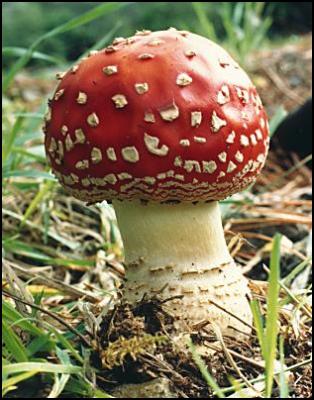Fungal foragers head for the beech

CAPTION: The 18th annual New
Zealand Fungal Foray is about to get underway - and foragers
will keep their eyes peeled for fly agaric mushrooms like
this one.
Photo: © Clive Shirley, Hidden
Forest
News Release - 6 May 2004
Fungal foragers head for the beech The 18th annual New Zealand Fungal Foray is about to get underway near Nelson, with an eye on fungal threats to our native beech forests.The six-day Fungal Foray usually attracts about 50 participants from both the science world and the general public, from here and overseas.
It is held every autumn in a different region of New Zealand. Fungi are collected with the Department of Conservation's permission, and are laid out for identification at the end of each Foray day.
They are later preserved and stored in recognised national collections to be used by researchers worldwide.The Foray organiser, Landcare Research mycologist (fungal scientist) Dr Peter Buchanan, says one focus of this year's Foray is to continue charting the presence of an exotic fungal weed, the fly agaric * Amanita muscaria, in forest areas and national parks near Nelson.
The fly agaric (the classic fairy mushroom of storybooks) is an established fungus often found under pine and oak trees, but has recently infiltrated our native beech forests as well. Dr Buchanan says the presence of fly agarics in these forests is of concern.
"Very few introduced fungi are found in native forests. Instead, they tend to be found in forests with introduced tree species, and in cities and disturbed land. Fly agarics are often accompanied by another introduced fungus, Chalciporus piperatus, a yellow-brown mushroom with tubes instead of gills. In effect, we have a double weed problem, and it is unclear how these weeds will affect the native fungi that benefit beech trees."It is disturbing to find fungal weeds in an undisturbed native ecosystem. Their presence says something about the health of the beech forests * but it's not yet clear what."As well as looking at fungal weeds, Dr Buchanan and the other foragers will be looking for new fungal discoveries.
"About 7,000 species of fungi have been recorded in New Zealand, and it is believed another 14,000 are yet to be found. We find new and bizarre fungi at most Forays. For example, most Forays typically extend records of fungi from that region by a hundred or more species. And some of the bizarre species have included one that looks like a shaving brush and another that resembles a brain.
"We remain keen to enlist the public's help in searching out new fungi, and enhancing our knowledge of the distribution of fungi we have already recorded.
"School children are particularly good at finding fungi, and pupils from local schools will be participating."
Also included on the Foray schedule is a Mycology Colloquium, where participants can present talks or posters on any aspect of mycology.
A special guest is Dr Harold Burdsall from the United States Department of Agriculture, an expert on wood decay fungi.The 18th New Zealand Fungal Foray: 9*15 May 2004Fungal foragers will be based at Brightwater near Nelson, and will scour the Mt Richmond Forest Park to the east, the Kahurangi National Park to the west, the Abel Tasman National Park and Farewell Spit to the north, and Nelson Lakes National Park to the south.Media are welcome to attend all or part of this event.
ENDS


 Nicola Gaston, The Conversation: NZ Budget 2025 - Science Investment Must Increase As A Proportion Of GDP For NZ To Innovate And Compete
Nicola Gaston, The Conversation: NZ Budget 2025 - Science Investment Must Increase As A Proportion Of GDP For NZ To Innovate And Compete Maritime Union of New Zealand: Maritime Union Condemns Threatened Job Losses On Aratere Ferry
Maritime Union of New Zealand: Maritime Union Condemns Threatened Job Losses On Aratere Ferry Science Media Centre: Proposed Increase To Glyphosate Limits – Expert Reaction
Science Media Centre: Proposed Increase To Glyphosate Limits – Expert Reaction Electricity Authority: Welcomes Plan For Boosting Consumer-Supplied Flexibility
Electricity Authority: Welcomes Plan For Boosting Consumer-Supplied Flexibility University of Auckland: How Can Finance Be Harnessed For Good?
University of Auckland: How Can Finance Be Harnessed For Good? Michael Ryan, The Conversation: NZ Budget 2025 - Economic Forecasting Is Notoriously Difficult, But Global Uncertainty Is Making It Harder
Michael Ryan, The Conversation: NZ Budget 2025 - Economic Forecasting Is Notoriously Difficult, But Global Uncertainty Is Making It Harder


